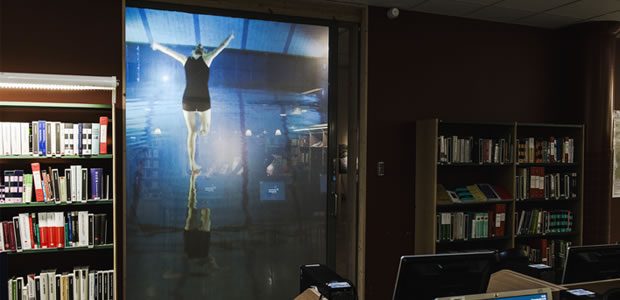
What can be described can also take place
LEAD ARTIST: DOMINIC STEVENS (IR)
ARTISTS: MATTIAS ÅKESON (SE) EWA AXELRAD (PL) JORUN KUGELBERG (SE) ELAINE REYNOLDS (IE)
The five artists had the opportunity, under the Locis programme, to meet together and explore the relationships and potential synergies between each artist’s practices. Notably, each of the five had worked in the past with themes concerning the relationships between people and the places they inhabit. Or more specifically, the relationship between body and space, ideas around architecture as a social product, the ways in which architectural space exerts control and the relationship between formally and informally created space.
Through periods of immersion and distancing, zooming in and out, the group hoped to come to a better understanding of Fittja. In between their two visits they continued conversations online, and during their time apart, Fittja remained an important point of reference for each artist’s individual research. They all stayed in the residence-apartment in Fittja and during their visits they met with citizens, planners, researchers, people from both within the structures of power and people upon whom that power is visited. From their position as outsiders or guests in the place and through their subjective experience of streets, shops, fields, people and conversations that were new to them, the group expanded their mental maps of the world and reconfigured their perceptions of the places from which they came.
Fittja was born out of a vision, a dream for a bright new future and its current state is again littered with new visions, plans for ‘development’, ‘liftings’ and ‘peoples palaces’. In keeping with this, the group used the form of the proposal to construct an exhibition that communicated visions of work that they had a wish to realise alongside work they had each made previously. The new proposals speak from Fittja but look at a whole spectrum of wider concerns.
 Dominic Stevens
Dominic Stevens
For the exhibition, Dominic developed a comic strip entitled How Fittja changed the world describing a new exciting future for Fittja.
“I believe in looking at things positively in a straightforward manner, so therefore I decided to explore the qualities that a very multi-cultural area like Fittja has to offer. The 21st century is set to be defined by the movements of peoples from one place to another and areas like Fittja lead the way and, I believe, have a duty to creatively teach the rest of the world how we can all live together in harmony. The piece explores how the physical act of building together can help build a sense of community; this is something that has been lost in the developed world.” Dominic Stevens
The screened film Some Structures from 2013 presents some perspectives and ideas that underpin Dominic’s architectural practice. The viewer is brought along through the organisation of space by a close reading of selected places in County Leitrim. The sites vary but all demonstrate a sensibility through a series of reflections on the customs, spatial culture and organisational methodologies that have been and still are employed in the management of people and space.
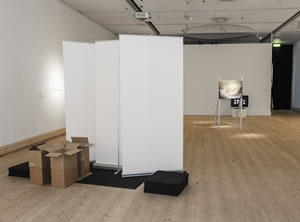 Mattias Åkeson
Mattias Åkeson
What can be described can also take place 1973 – 2013 (Roll-ups)
“Roll-ups are about visions. The meeting between desires, wishes, estimates and plans in relation to the physical location. We live in a time where every place must have a vision. All activities and all of life are tinted by a capitalist worldview. Upward, forward and straight ahead. PowerPoint aesthetics. It characterises our language and our view of how we should live our lives and what places look like.” – Mattias Åkeson
The proposal included a printed booklet with sentences from the municipality’s marketing material stretching forty years back. Mattias’ intention was to develop the material into an audio guide and a physical intervention of citations in residential areas.
The work An exercise of form and shape comes from Mattias’ seven year old son who was given the task to design the cover of the first edition of Émile, ou De l’éducation from the year 1762, by Jean-Jacques Rousseau (1712- 1778). Émile served as inspiration for what became the new (French) national education system. Rousseau considered knowledge a weapon. The masses were to be educated, enlightened and formed in order to be free. Rousseau also had an interest in copying and spent a lot of time copying music. Mattias’ son spent around two hours to complete his copy of the book cover. In Swedish the title reads ‘Om uppfostran’ (On Education).
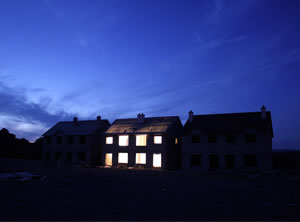 Elaine Reynolds
Elaine Reynolds
Elaine developed Promisings as a proposed work, which enters into a dialogue with the archive of promotional material that exists in relation to Fittja and the current plans for the regeneration of this Million Programme Housing area. The work borrows visually from the commercial proposal and the ideological assurances of architectural master plans. Promisings gestures towards inherently propositional forms; The mood board is a tool for communicating a design concept, to quickly inform others of the overall ‘feel’ and ‘flow’ of a proposed idea. The ‘PowerPoint presentation’ has come to function in a similar way, it serves to build a convincing narrative around the concept, the pitch. In this case, the viewer encounter an analogue version of a PowerPoint presentation, disconnected, printed out and hung on the wall. The visual language points to some ideal form, or place, or lifestyle but the presenter, who would elaborate on these slides is absent.
Two previous works by Elaine were also presented in the exhibition Rural Renewal and On/Off States. The works are connected to the Rural Renewal schemes initiated by the Irish government in response to a housing crisis in the late nineties. In 2008, the economy entered into dramatic decline and many of these projects were abandoned. The countryside is now host to countless unfinished, un-inhabited ‘ghost estates,’ uncomfortable monuments to a deregulated housing market. The Rural Renewal work depicts an advertisement for one such housing development in Leitrim. On/Off States documents a live event that took place the same abandoned ‘ghost estate’ depicted in Rural Renewal. Industrial lights were installed within the concrete cell of an unfinished home and were programmed to flash on and off in Morse Code sequences.
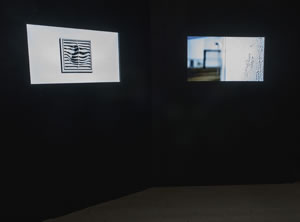 Ewa Axelrad
Ewa Axelrad
Between the Windscreen and the Rear-view Mirror was a proposed work that used a fictitious book as a pretext for guided tours to be organised in Fittja. The idea of the project uses the phenomena of city tours in the footsteps of fictional characters that have become widely popular in Stockholm recently.
“Since the Polish landscape is saturated with memorials and references to the past, I’m interested in Sweden‘s relationship with its past and potential within fiction for revisiting it. The project further seeks to consider how collective memory can be imprinted into the urban space through the use of guided tours that aren’t related to reality.” Ewa Axelrad
Two previously made video works, part of the CODA series from 2012, and made in collaboration with Steve Press were screened. The videos are shot at an abandoned industrial estate CODA imagines a moment of a complete yet almost imperceptible heat-induced entropy.
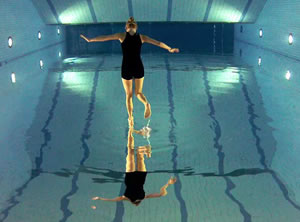 Jorun Kugelberg
Jorun Kugelberg
In the video work Trespassings, developed for the exhibition, Jorun focused on the two spaces of Botkyrka konsthall and the library in Tumba that are separated only by a glass door. These are two public places but with different conditions; a place for literature and reading and another to discover and explore contemporary art. Jorun was interested in exploring the boundaries between them; developing a video work that was projected on the glass door. Trespassings is about renegotiating solid surfaces and concepts.
The video work Place as event from 2012 was projected outside of the exhibition space in Botkyrka konsthall, on the wall next to the entrance door.
“We move along pre-taught lines. Lines that shows the direction and that creates boundaries; separating the outside from the inside, the centre from the periphery. Lines that we follow because they exist; as well as exist because we follow them. In this film I interact with a place that has momentarily been a part of my everyday life. In order to go against my learned choreography, I try not to plan a single movement before it happens. The result is a countermovement against boundaries and restrictions, as well as an investigation of what it means to be in one location.” – Jorun Kugelberg
“What can be described can also take place”
Wittgenstein: Tractus Logico Philisophicus
I graduated from Architecture school in 1989. In 1995, after working in Berlin I returned to Dublin and started private practice. In 1999 I relocated my practice to rural County Leitrim. I now divide my time between building, architecture and teaching. My practice focuses on making buildings and theoretical projects in the Irish countryside.
I am interested in researching by doing things, by taking action, and then reflecting upon what I have done in order to learn. If you want to learn how to dance you have to start dancing! I believe that acting or doing allows us to respond to our deeper selves, to the places within that we may never access if we begin by intellectualising.
I came to Fittja with a strong interest in the vernacular, of empowerment through the creation of one’s own dwelling. Fittja was the antithesis to this way of thinking. It embodied the very thing that Heidegger criticised in his essay Building Dwelling Thinking of 1951 presented at a conference on housing, which celebrated the success of the post war housing programme (of which Fittja represents the tail end). I wondered how so many people from different places with strong local building (and therefore spatial) traditions could live in this neutral place created for them.
Ewa Axelrad creates distinctive installations, usually employing the qualities of already existing spaces. The minimalism of the provided architecture usually gets interrupted with photographic images she places in its interiors. The introduction of naturalistically depicted bodies becomes an equal counterpoint to those sterile spaces. Together they form often radical common messages referring to the condition of modern society. These multi-dimensional pieces are the result of meticulous work carried out on a preliminary conceptual level. The idea permeates the consciousness of the recipient through the sensual pressure exerted by the surprisingly expressive surrounding. That successful transmission of an idea is possible through a skillful spread of its content ‘…onto architecture and images placed in its interiors. Moreover a participant of the exhibition becomes a victim of the role discretely shifted from the figures on the photographs onto him or her’. (Piotr Pękala)
Mattias Åkeson studied at the Art Academy in Bergen, Norway and graduated in 2001. He was is one of the founder members of the Norwegian Artist group gutengut (1999 – 2004) whothat made a wide range of interdisciplinary projects working with performance, video, installations and social interactions. Today he divides his time between artistic practice, teaching and commissions.
His fields of interest could be explained as dealing with Scandinavian welfare, middleclass consumption identity, and the relation between community as a collective and the individual. He has been doing projects looking at the shopping mall, the the art gallery and the the kindergarten. The relationship between architecture, activity and user is an important base for his practice.
In 2009 he published the book Northern Comfort (Labyrinth press),which containsa book containingessays and aseries of photographs dealing with the sShopping mall. In 2012 he had an was Artist-in-Residence atIngmar Bergman ́s home on Fårö, Gotland. Recent projects are include the exhibitions Cash Flow / Konsumera mera (More consumption) at Botkyrkakonsthall and Norrköping Museum of Art, Hem ljuva hem (Home sweet home) at Konsthall C in Stockholm, and Barnstugan (The Kindergarten) at Gallery 54 in Gothenburg. At the moment he isworking on a publication about Barnstugan.
With a background in drag and queer burlesque performance, Jorun Kugelberg continuously explores how the moving body can challenge the conditioning that it is being subjected to by its surroundings. Her work is mainly concerned with places that play a part in the every day lives of many people and as a consequence her installations tend to happen outside of the white cube. Recent works are site-specifically installed video projections. Here, one reality is projected onto another but both are equally important actors in the piece – enhancing, altering and expanding each other. Jorun’s work deals with the connections between and the codependence of mental and physical space. A reoccurring theme is how seemingly abstract political paradigms gets materially manifested in, and negotiated through, architecture and the planning of the city.
My work addresses aspiration, lifestyle, embeddedness and isolation as they are determined in an increasingly complex global economy. Through combinations of moving image, installation and site-specific modes of working, I aim to identify ideological assurances in the everyday and to comprehend the channels through which they are produced and disseminated. This approach has brought me into contact with unique communities and diverse architectural spaces; from abandoned ‘Ghost Estates’ of post Celtic Tiger Ireland, to the modernist Stockholm suburbs of Fittja and the mining camps of North Western Australia. Recent works gain access to materials via the internet, the resulting experiments in expanded film, montage and docu-fiction follow an approach that reflects the logic of this networked condition. By mapping relationships between sites I aim to understand my own place in a complex global system of movement and exchange.